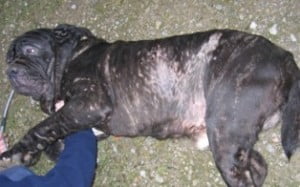Pet Advice Guides for Pet Owners
When Mange Strikes
 It’s not a pretty sight is it?
It’s not a pretty sight is it?
This poor dog came in as a stray and had to be treated straight away. He was feeling very sorry for himself. But mange can strike even the most well cared for pet. The skin can be covered in pimples, or it can be hairless. It might be thickened and oozing and all this is caused by a mite that burrows under the skin. Sometimes the mites multiply beyond their normal levels and the situation becomes acute.
Any hairless patches on a dog can be caused by mange and veterinary diagnose and treatment is essential – see your vet right away. There are different types of mange and scabies which is an associated condition – the vet will be able to tell which one your dog is suffering from and prescribe the appropriate treatment.
There are ways to help prevent your dog from getting mange and to help him get over it in conjunction with his medication. Keeping him in tip top condition is one of the best ways to keep skin conditions at bay. When a dog is run down or suffering from some other illness, his immune system can’t cope and he can’t repel the invaders. Keeping him clean helps, regular grooming gets rid of scabs and unhealthy skin. Bathing with a naturally medicated shampoo helps to keep him fit also. The vet will most likely prescribe a special shampoo to bathe him in – and a lotion to put on afterwards.
Low nutritional standards, poor nourishment – he may be eating enough but is it good, natural food? Mange often affects pets that are in poor general health or malnourished. A good diet makes for a healthy, vigorous dog. Check out the ingredients in your pet food. Animal derivatives? What does that mean? It’s like us eating packaged convenience food – we are what we eat and so is your dog. Only the best and purest ingredients will do.
It’s possible that feeding fatty acid supplements will help. Ask your vet for advice. We’ve found cod liver oil, sardines in oil and a bit of olive oil on the food are all of benefit. The dog’s skin gets in better condition and he can start to heal himself. If he has succumbed to this horrid skin infection, you will have to begin again with all his bedding. Either wash thoroughly and hang out in the sun to dry or throw everything away and start over. Don’t forget where he sleeps – if it’s the sofa or a favourite chair you’re in trouble! Hoover and wash and put out in the sun – fresh air and sunlight are good natural cleansers. I like to sprinkle lavender in the bottom of a pet bed, also wipe over with natural orange or lemon cleansers or tea tree is good also.
Get your pet out in the fresh air as much as possible. This doesn’t mean leaving him out to shiver though. He may feel totally miserable if his coat is infected. He needs active exercise in sunlight, but not high temperatures, that would be just as bad. Avoid extremes. If he has caught mange you’ll have to forgo the hugs for a while – it is transmissible to humans, so wash your hands after handling him.
You’re asking yourself how your well looked after pet could have caught such a horrid disease? From other dogs is one possibility. If you see a dog with hair loss and he’s scratching as well – don’t let your pet near him. You may be taking his bugs home with you. Another culprit is the fox. Mange is endemic in the bushy tailed fox population. They itch and scratch and pass it on. If your dog is rooting round in foxes dens, he could well pick it up. Again, a fit, healthy dog will be less likely to bring the mange mite home with him, than a dog in poor condition with a dry, dull coat. Foxes sometimes become quite hairless with a severe mange infestation. For them the only cure is a natural one. Plenty of sunshine, a regular diet of rabbits, a change of den and they will usually recover on their own.
